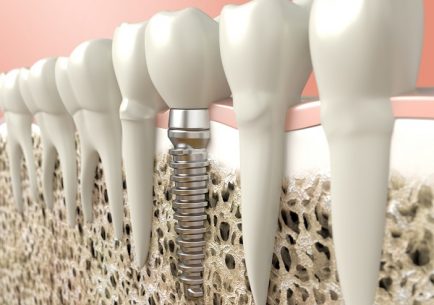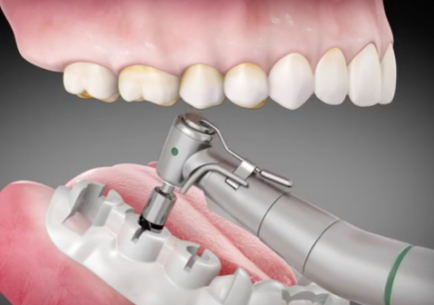Implantation
- All-on-six implantation
- Traditional implantation
- Digital implantation
- Sinus lift
- Extreme implantation cases

Services
All-on-six implantation
The leading service of our dentistry is the immediate dental implantation – also known as All-on-six implantation – which is considered to be the most modern dental implantation procedure available today. Quality and comfortable tooth replacement for all patients who have a complete lack of teeth or several missing teeth next to each other. The essence of the procedure is that a few days after the implant is implanted in its place, the temporary denture is put in place fixed by screws.
The teeth may be used immediately thanks to the massive fixation.
The entire denture is placed on only 4, 5 or 6 implants. Implantation can also be performed in case of unfavorable bone supply.
Once the healing period is over, the temporary denture can be simply unscrewed without any surgical procedure, and once the new permanent replacement is ready, it can be simply screwed on. Our consultation and individualised treatment plan is free of charge. We welcome your application!

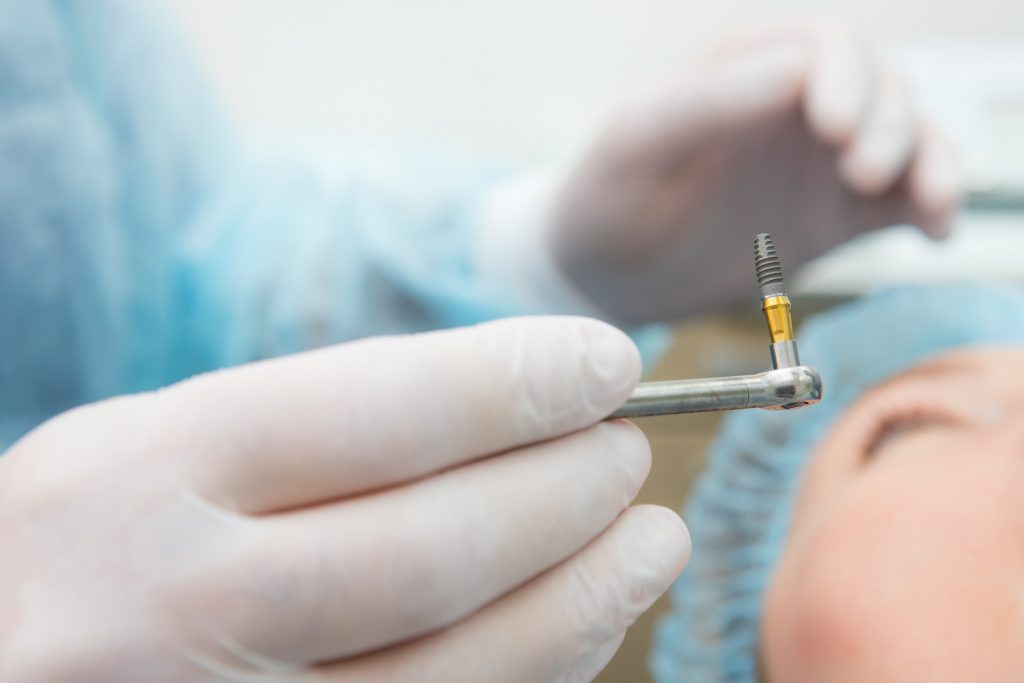
Traditional implantation
Dental Implants
Tooth loss or deterioration of the aesthetic condition of teeth is a distressing experience for everyone. Chewing can become more difficult and aesthetically unpleasant, as many people may think that these people do not care about their teeth.
Implant procedures are the main field of activity at our clinic. Partial or removable tooth replacement methods often cause various difficulties when eating or speaking. These can be eliminated by the implantation of dental implants. Functionally and aesthetically, dental implants are a long-term and secure solution. Our dental practice uses revolutionary, precise and innovative methods. We also strive to be at the forefront of the latest techniques in the profession.
Materials for dental implants
Our dentistry always offers a personalised solution, which is why we choose the most aesthetic, precise and appropriately shaded materials for the final result.
We only work with the best materials. The implants we use are made of pure titanium and surface-treated to ensure that they are able to bond as perfectly as possible with the patient’s own bone structure over the long term. Implant dentures are as strong, usable and beautiful as the original teeth. The modern method of tooth replacement replaces missing teeth by implanting an artificial root (dental implant) and placing an abutment on it.
What is a dental implant?
A dental implant is an artificial root made of a biocompatible material that is implanted in the jawbone. A screw-in structure is used to fix a crown, bridge or other tooth replacement that is implanted in place of the lost tooth. This is used as an artificial root.
In most cases, the implants are made of pure, non-alloyed, grade 5 titanium, which is produced for medical purposes. This means that even if the patient has allergies to several different metals, there is no need to worry, as titanium is fully accepted by the human body. Developed on the basis of decades of implantology research and experience, the implants meet the highest European requirements. With the right implant placement technique and a professionally designed and correctly constructed abutment, implants can last a lifetime.
Who can dental implants be recommended for?
Dental implants can be recommended for all patients who choose this option, who have no contraindications and who are willing to comply with the oral hygiene rules recommended by the dentist.
Factors that may be considered as risk factors:
- excessive alcohol consumption
- drug addiction
- heavy smoking
- certain medications
Who is at risk for dental implantation?
Unfortunately, certain diseases can reduce the success of implantation. These include:
- untreated diabetes
- severe cardiovascular disease
- bone diseases (certain drugs containing biophosphonates)
- severe bone deficiencies
- tumors
Implants may not be placed before the jawbone has finished growing (until about 18 years of age).
The steps for dental implant placement
- During a free preliminary consultation, we will assess whether the implant can be placed. We always take into account the best interests of the patient, but the most important to us is that the procedure is free of complications. The examination is divided into two parts:
- During the dental examination, the dentist assesses the jawbone’s suitability for implantation. During the assessment, additional information about the patient’s condition can be obtained by means of a CT scan. This information is used to determine the exact location of the prosthesis and to select the type of dental implant.
- Depending on the type of dental implant selected, a general medical examination may be carried out. During the general medical examination, the patient’s results from the general practitioner, the specialist and the laboratory results can be used to assess the risks of the procedure.
- After the examination, the patient shall receive a detailed treatment plan.
- The implant surgery is performed, followed by the recovery period, which usually lasts 4-6 months.
- 4. After the recovery period, a follow-up is performed and the prosthetic abutment is made.
After the prosthesis
Keeping your mouth clean and having regular dental check-ups are the most important factors for the long-term success of implantation. GGDent Dentistry recommends that you should have at least one check-up per year after the implant placement.
It is important for the patient to be aware that if any changes are noticed in the meantime, they should be checked as soon as possible. The dentist shall check the bone and epithelial adhesion around the implant, check the condition of the prosthesis and, if necessary, make the appropriate corrections (e.g. removal of dental plaque from the surface of the prosthesis).
What type of dental implant should I choose?
Dental implants started to be marketed in Hungary decades ago. There are currently more than 50 different implant brands available on the market. It is important to know that not every dentist has the right equipment for every implant system.
The choice of implant brand is a choice for decades to come, but it also means that the patient may not be able to use the services of other dentists, for example because of moving, due to subsequent dental repair work. Compatibility was therefore an important consideration when choosing the system. This means that we chose a system that is currently compatible with the most commonly used implant brands in the world.
By using the implant system, and with the cooperation of the patient and the dentist, it is possible to achieve a natural and lifelike tooth replacement, which contributes to the creation and maintenance of a feeling of comfort in everyday life. It should be remembered, however, that tooth replacement is not only an aesthetic correction, as tooth loss or gaps in the dentition can cause existing teeth to slip and move apart, giving rise to the possibility of negative changes affecting several teeth.
The success and popularity of the Implantation System is evidenced by the 150 types of dental implants used, of which thousands are implanted worldwide every year. The excellent results achieved using these advanced products have brought widespread recognition to both dental patients and dentists.
Key aspects:
- quality
- surface treatment
- strength, flexibility
- good biocompatibility, perfect compatibility with human bone tissue
- technical possibilities within the system, i.e. for everybody
- there should be some possibility
- fitting, accuracy
- compatibility with other systems
- maximising value for money
What are the benefits of dental implantation and prosthodontics?
The advantage of using dental implantation for short-interproximal tooth loss is that an implant is placed in the place of the root of the lost tooth and the tooth replacement is built on top of this. Whereas tooth replacement using traditional methods can (unfortunately) only be achieved at the cost of tooth preparation performed on the fully intact teeth next to it.
Implantation also offers a solution for fixed tooth replacement where the loss of chewing teeth would mean that only partial or removable tooth replacement could be achieved by conventional dental methods. The main advantage of implantation, apart from the excellent aesthetic effect, is that the implant allows for greater stability and improved chewing ability, as well as a great increase in the feeling of security.
The advantage of implants in cases of complete tooth loss is that they can be used as a pillar to support the prosthesis in several ways: on the one hand, the anchoring elements anchored to the implant can be used to hold the removable prosthesis in place (with the help of so-called “ball retention”). On the other hand, if a sufficient number of implants are placed, a fixed prosthesis can be made (circular bridge or overdenture tooth replacement).
The advantage is that individual wishes and possibilities can be fully taken into account. In the case of an implant procedure, where the tooth replacement is made onto the patient’s own teeth and/or implants, the fixation can be done either in the traditional way by tooth bonding or by screw fixation, which can be removed by the dentist. With the help of the elements of the implant system, the implantation or tooth replacement can be personalized using the most modern materials and technology, which ensures the desired comfort and a higher quality of life.
This material is not soluble in body fluids and therefore does not react with the immune system. The implant is made of high-purity titanium, which has a special biological property that allows the bone to fuse and integrate with it.
Is there a risk of allergies or tumor development associated with the implantation?
In the professional literature, there is no mention of any allergy or tumor degeneration associated with the placement of an implant, the surface of which is made up of a stable compound, titanium oxide. With a correctly chosen implant placement technique and a professionally designed implant architecture, the implant system can serve for a lifetime and no tumor illnesses are to be expected.
PRESS RELEASE
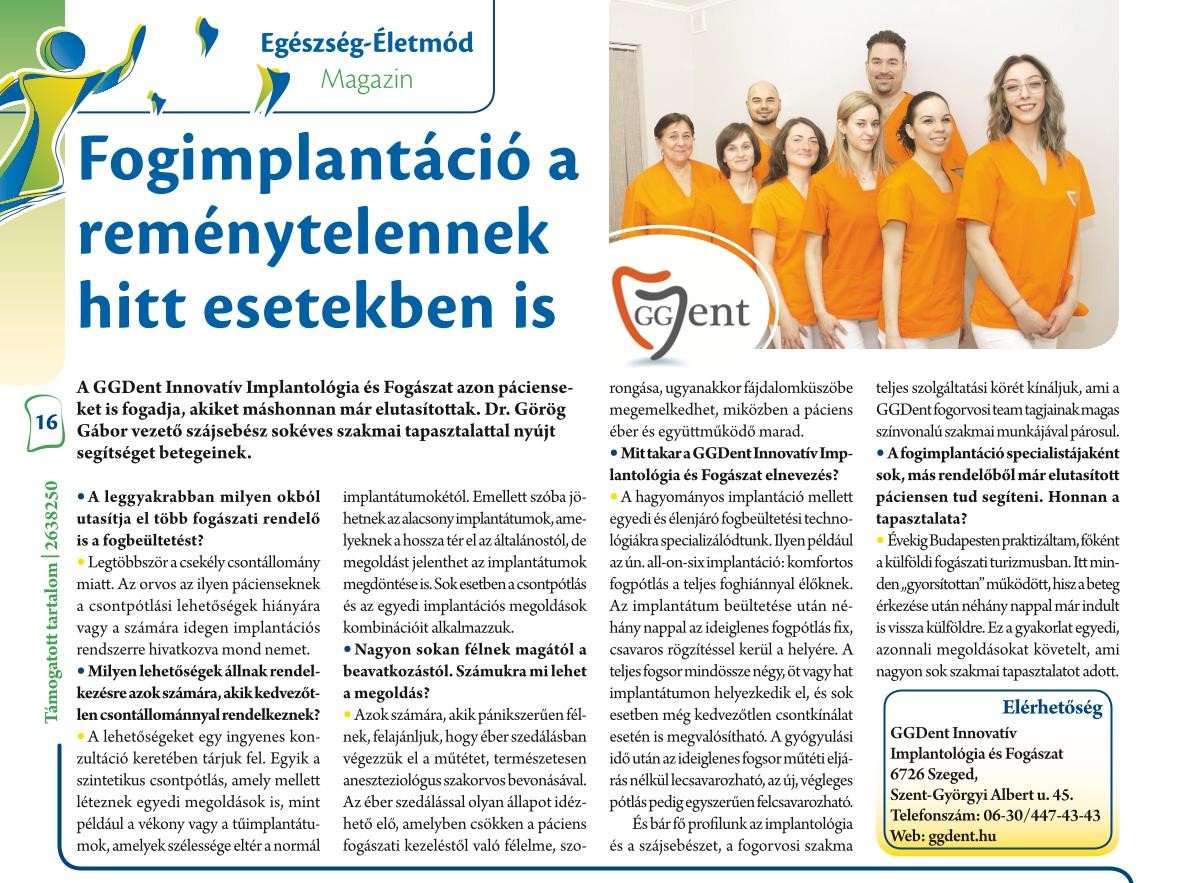
Tooth implantation in cases believed to be hopeless
GGDent Innovative Implantology and Dentistry usually takes care of the patients rejected by other dentistries. Senior oral surgeon, Dr. Gábor Görög, helps patients with many years of professional experience.
Délmagyarország Health magazine annex 2022.04.16.
Digital implantation
About digital implantation
One of the most precise ways of implantation. It allows us to solve many seemingly impossible cases where, for example, the proximity of a nerve would not allow hands-free surgery. After a digital CT scan, the surgery is planned on a computer. The implant is digitally placed to an accuracy of tenths of a millimetre, a 3D printer prints a surgical guide for it that determines the direction and depth of the implant hole. The preparation of the hole and the implantation is therefore carried out through a gum wound of a few millimetres, to which the replacement will be subsequently fixed.
The process can be summarised as follows:
1. Medical consultation
Your dentist will inform you about the details of the treatment and the Surgical Guide.
2. 3 dimensional diagnostics
A CT scan of the area of tooth loss is taken to map the bone tissue and soft tissue. The scan is completely painless and takes only a few seconds.
3. Computer-aided surgical planning
Based on the CT scan, your dentist will plan the implantation procedure in a relaxed environment using a computer. Thanks to the planning software, the positioning and optimal size of the implants can be perfectly modelled, taking into account the amount and quality of bone available, as well as the location of the nerve canals and sinuses, facial cavities. The device is ordered and delivered to our clinic within a few weeks.
4. Implantation procedure
A custom-made surgical guide tool – implantation template – based on the surgical plan is used to perform the procedure. The use of an implant template ensures that the implants are placed perfectly in their intended position and that you experience as little discomfort as possible.
5. Dentures ready
Once the implants are placed in the optimal position, your dentist will prepare the most ideal prosthesis possible after the healing period.
Sinus Lift
Procedure for the upper jawbone. It is necessary when the jawbone ridge thins or its vertical height collapses after the removal of an upper back tooth.
Upper natural teeth usually have three roots. The roots, like the legs of a three-legged chair, diverge. The bottom of the sinus smoothes into the roots in a spherical manner, so that the roots of the teeth are spatially spaced out. When a tooth is removed, the bones lose volume during healing, often to the benefit of the sinus cívity. Therefore, there are cases where there is not enough bone left to place a full-sized implant of about 10 mm in place of the removed tooth. In this case, a special procedure is used to carefully lift the mucous membrane at the bottom of the sinus cavity and insert synthetic bone (bone graft or bone replacement) to fill the base of the sinus cavity, which will later transform into bone of its own and be able to hold the implant.
There are two types of sinus lifts: closed and open. Closed lifting is possible when the bone thickness reaches at least 5 mm. In a procedure lasting about a few minutes, it is enough to raise the base of the sinus cavity with a few movements through a drilled hole of about 3 mm. The amount of bone substitute is minimal and can be introduced through the small gap mentioned above. If there is an option, it is always recommended to do this. The risks are lower and the amount of bone substitute is less, there is more of the patient’s own bone so the chances of success are quite high.
If the remaining bone is between 5 and 0 mm, the lift should be done with open sinus surgery. In this case, the facial cavity is opened up and a larger amount of bone graft is inserted. The implantation is sometimes immediate but sometimes delayed for months. This depends on the quality and strength of the existing bone. The worse the bone quality, the greater the risks.
It is worth noting that the sinus lift as a procedure was added to the list of oral surgery procedures about 30 years ago, when implantation became a “general” procedure. At that time, vertical implants were inserted and straight head pieces were placed because that was what was available. So the intervention is generally associated with classic implantation cases as a necessary supplement only when there is no other option. In the vast majority of cases, doctors also prefer to avoid it, and this is evidenced by the fact that newer technologies have been developed which, with more advanced components and procedures, have made this procedure avoidable in many cases.

Extreme implantation cases
Dental implantation has a history going back a few decades. Most of those who had dental implants in the beginning now have problems: destroyed prostheses, atrophy of existing bone, or simply not enough bone left after tooth removal to use for a possible reimplantation. In such cases, most dental practices will determine after an examination that the patient does not have enough bone and therefore cannot be implanted. This means that the old-fashioned full removable prosthesis can be used, which of course the patient does not like at all.
We have had many patients come to us with this problem. But no need to lose hope, because if right equipment is available, there will always be options. In such cases, it is almost certain that conventional methods will not achieve the desired results, so we try to use techniques that have different characteristics and open up new possibilities. We can work with the following methods or combinations of them:
1. Bone grafting
Unfortunately, we are experiencing an increasing number of cases of bone defects. Bone grafting is usually considered as a supplementary method and is only used when there is no other choice. The reason is that inanimate, uncirculated granules can easily be infected by oral flora, making bone grafting unsuccessful. In our practice, we use synthetic bone substitutes.
2. Partially removable replacement with implant
In many cases, this can be a solution because, unlike fixed prostheses, implants can be placed anywhere where there is a right amount of bone. For example, if there is not enough bone in the incisor site (fore-teeth) but there is enough in the posterior region on both sides, the implants and the fixation mechanism will be placed on both sides in the posterior region.
3. Thin or needle implants
For patients who have very thin available bone for tooth implantation, implants of average size cannot be used. There are, however, so-called needle implants, which are much thinner than the traditional sizes and can be a solution and allow tooth implantation in these cases.
4. Tilted implantation with angled head and screw fixation
Occasionally it is possible to avoid bone grafting with a tilted implant, for example in the sinus or nasal cavity. It is particularly convenient to place the implant in the patient’s own bone over its entire length instead of bone grafting, as the risks are minimal and the stability is perfect, for the reason that the entire surface is bonded to the bone structure.
Image: top left implant 6 inserted in a tilted direction, just avoiding the facial (sinus) cavity.
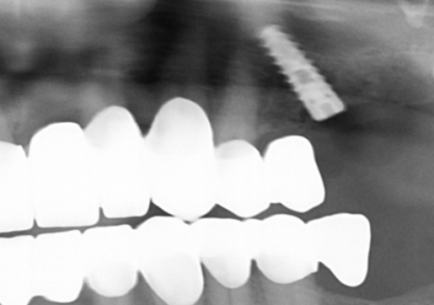
Tilted implantation with angled head and screw fixation
5. Tuberal implantation
In many cases, even with the worst bone supply, there are fixed sites where bone can be found. One of these sites is the back of the maxilla, which, although soft bone, is usually thick enough to be used. True, not by using the classic methods, but it can mean a solution.
Pictured: Instead of a left upper implant sinus lift we chose tuberal implantation.
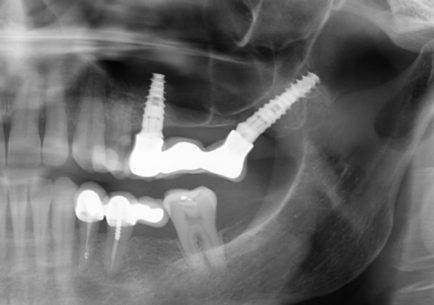
Tuberal implantation
6. Digital implantation
Based on the patient’s own CT scan, we digitally plan the future location of the implant. The nest is then shaped using a prefabricated template, taking care to avoid the surrounding tissue and the nerve canal.
7. Custom implantation solutions
There may be cases where almost no solution is possible for the patient and none of the above mentioned solutions are feasible. However, this does not mean that there is no solution: today’s advanced technologies allow us to make a custom-made implant or implants based on the patient’s own CT scan. This is all thanks to 3D design, printing and milling with hundredths of a millimetre precision. This may be known in traumatology in case of a hip replacement or a lost limb that can be replaced with a manufactured part.
PRESS RELEASE
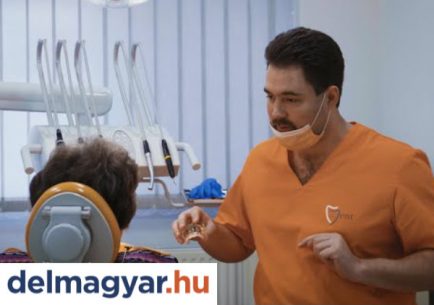
At GGDent there is a possibility of tooth implantation in case of extreme cases too
Don’t give up! There is hope for those patients, who were rejected by other dentists! Professionalism and modern dental tools help people waiting for unique solutions because of their unfavorable bone mass.


